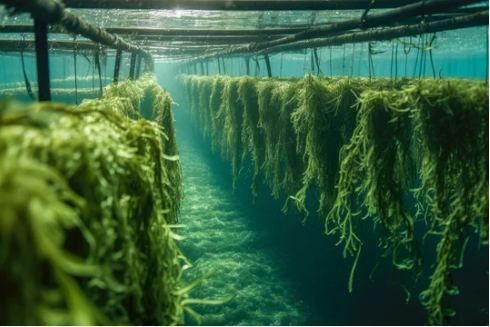Seaweed in agriculture: how can we use it?

Christiana Jones
Student at SR University, School of Agriculture.
This post is also available in:
This post is also available in:
![]() Español (Spanish)
Español (Spanish)
Seaweed in agriculture offers a promising avenue for sustainable farming practices. Its application includes soil enrichment, providing essential nutrients, and enhancing plant growth. With versatile seaweed uses, such as biofertilizers and soil conditioners, integrating seaweed into agricultural processes can contribute to increased crop yields and environmental sustainability.
Seaweed in agriculture:
1. Biofertilizers and soil amendments: The transformation to sustainable and nature-inclusive agriculture requires a reduction in the use of chemical fertilizers. Seaweeds are packed with essential nutrients like nitrogen, phosphorus, potassium, calcium, and magnesium, making them fantastic natural fertilizers. They also contain micronutrients, amino acids, and enzymes that promote plant growth and root development. Additionally, their polysaccharides improve soil structure, aeration, and water retention, leading to healthier and more productive soil.
2. Biostimulants for enhanced yields: Seaweeds are nature’s growth boosters. They contain hormones and other bioactive compounds that stimulate plant metabolism, increasing chlorophyll production, photosynthesis, and nutrient uptake.
3. Frost protection for delicate crops: Spring frosts can be a farmer’s worst nightmare. Seaweed extracts can provide an affordable solution for that matter. When applied before a frost, they coat the leaves with a protective film, creating a microclimate that insulates tender plants and prevents ice damage.
4. Animal feed supplements: Seaweeds offer valuable nutritional boosts for livestock. Their protein, minerals, and vitamins enhance animal health, improve digestion, and even contribute to better milk production and meat quality. This translates to healthier animals and potentially higher yields for farmers.
5. Disease and pest control: Seaweed extracts have natural antifungal and antibacterial properties that can help control diseases and pests. They also stimulate the plant’s defense mechanisms, making them less susceptible to attacks. This eco-friendly approach promotes sustainable agriculture and reduces reliance on harmful chemicals.
6. Wastewater treatment and remineralization: Seaweeds are nature’s pollution fighters. They can effectively remove heavy metals, nitrogen, and phosphorus from wastewater, making it safe for agricultural irrigation. Additionally, they release minerals back into the water, replenishing vital nutrients for future plant growth.
Seaweed in Pharmaceuticals:
1. Antiarthritic nutraceutical: Contains 100% natural marine bioactive ingredients extracted from selected brown seaweeds, viz., Turbinaria ornata and Turbinaria conoides. Decreases production of inflammatory prostaglandins and leukotrienes, thereby hindering inflammatory pain and arthritis. The product is marketed as Green Algal Extract (GAe)
2. Antiabetic nutraceutical: This contains 100% natural marine bioactive ingredients that induce type-2 diabetes and interfere with the release of simple sugars from the gut. This further reduces postprandial hyperglycemia, thereby hindering the occurrence of type-2 diabetes. The product is marketed as Antidiabetic Extract (ADe)
3. Anti-hypercholesterolemic nutraceutical: Contains 100% natural marine bioactive ingredients extracted from selected brown seaweed., Sargassum wightii. Attenuates high fat-induced hyperlipidemia, characterized by a significantly lower level of serum LDL, lipid peroxidation status, and lower atherogenic index. The product is marketed as Antihypercholesterolemic Extract (ACe).
4. Antihypothyroid nutraceutical: The product is developed from 100% natural marine bioactive ingredients isolated from selected brown seaweeds, Sargassum wightii, Turbinaria ornata, Turbinaria conoides, and red seaweed Kappaphycus alvarezii. The bioactive ingredients in ATe stimulate thyroid-releasing hormone and increase the activity of selenodeiodinase to produce metabolically active triiodothyronine, thereby hindering the product marketed as Antihypothyroid Extract (ATe). occurrence of the hypothyroid disorder.
5. Antihypertensive nutraceutical: Selected brown seaweed, viz., Sargassum wightii, isolated 100% natural marine bioactive ingredients for developing the product. The product is marketed as an Antihypertensive Extract (AHe).
6. Antiostereoporotic nutraceutical: Contains 100% natural marine bioactive ingredients extracted from selected red seaweed, viz., Gracilaria salicornia, and brown seaweed, viz., Sargassum wightii. The product will be marketed as Antiosteoporotic Extract (AOe).
7. Immune booster : The product contains 100% natural marine bioactive ingredients extracted from selected brown seaweeds, viz., Turbinaria conoides and Sargassum wightii. The product will be marketed as Immunoboost Extract (IBe). It can be promoted as a novel immunity booster, which is 100% natural.
8. Antibacterial skin care ointment: Contains 100% natural marine bioactive ingredients extracted from selected red seaweed, viz., Kappaphycus alvarezii and seaweed-associated Firmicutes. The product will be marketed as Antibacterial Extract (ABe).
9. Probiotic supplement: The product is developed from 100% natural marine bioactive ingredients extracted from seaweed-associated Bacillus amyloliquefaciens MB6 along with extract of red seaweed, viz., Kappaphycus alvarezii. The product will be marketed as Maribac (MBc).
10. Dietary supplement: CIFTEQ® FucoidanEx is a freeze-dried supplement rich in high-value nutraceutical Fucoidan and micronutrients. It forms as an ingredient in various nutraceuticals and cosmetic products. The product extracted from Sargassum wightii is also a source of essential micronutrients, taurine, and antioxidant pigment fucoxanthin.
If you want to learn more about seaweed in agriculture, read this article by the same author. For relevant content related to Aquaculture, click the link.
References:
BOOK – ICAR Technologies: High-Value Nutraceutical and Nutritional Products from Seaweeds Editors: A. Gopalakrishnan, C. N. Ravishankar, Pravin, J.K. Jena
Christiana Jones
Student at SR University, School of Agriculture.Dedicated and enthusiastic professional student who is an Applied academic interested and passionate about research and development. I thrive in the unknown, fueled by a relentless passion to uncover, create, and push the boundaries of knowledge in the field of Agriculture. Very glad to be a part of Wikifarmer\'s Library as a contributor author to share the knowledge about farming across the globe.
Join our editorial team
Join our community and contribute to Wikifarmer, a platform based on the knowledge of a diverse community of farmers and people working in the agricultural industry from all over the world.









































































